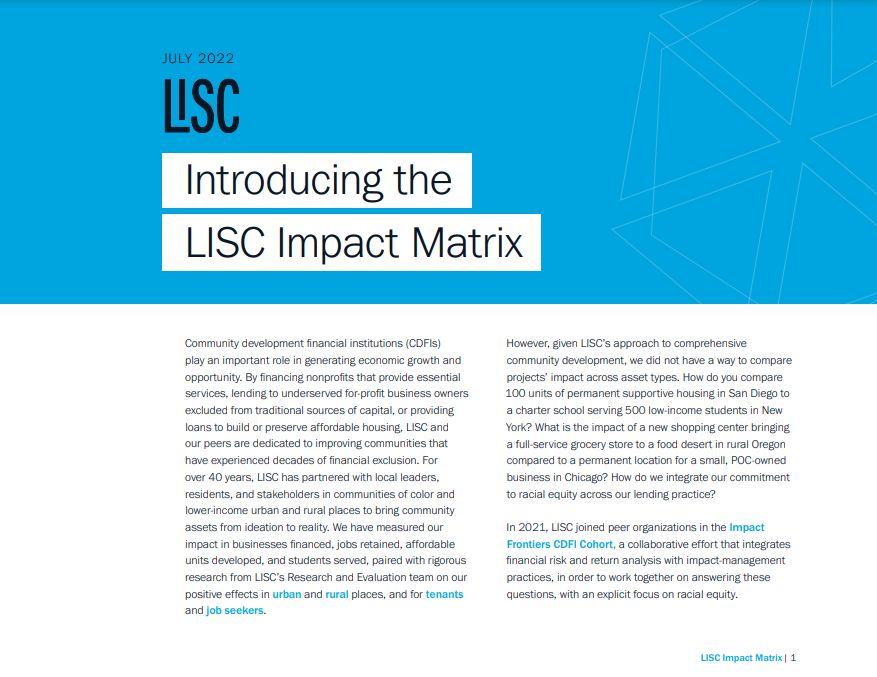LISC Impact Matrix
LISC’s Impact Matrix is the first step in using a data informed approach to refine how we incorporate impact into LISC’s loan process. The matrix leverages existing quantitative and qualitative data collected during the underwriting process.
Introducing the LISC Impact Matrix
Community development financial institutions (CDFIs) play an important role in generating economic growth and opportunity. By financing nonprofits that provide essential services, lending to underserved for-profit business owners excluded from traditional sources of capital, or providing loans to build or preserve affordable housing, LISC and our peers are dedicated to improving communities that have experienced decades of financial exclusion. For over 40 years, LISC has partnered with local leaders, residents, and stakeholders in communities of color and lower-income urban and rural places to bring community assets from ideation to reality. We have measured our impact in businesses financed, jobs retained, affordable units developed, and students served, paired with rigorous research from LISC’s Research and Evaluation team on our positive effects in urban and rural places, and for tenants and job seekers.
However, given LISC’s approach to comprehensive community development, we did not have a way to compare projects’ impact across asset types. How do you compare 100 units of permanent supportive housing in San Diego to a charter school serving 500 low-income students in New York? What is the impact of a new shopping center bringing a full-service grocery store to a food desert in rural Oregon compared to a permanent location for a small, POC-owned business in Chicago? How do we integrate our commitment to racial equity across our lending practice?
In 2021, LISC joined peer organizations in the Impact Frontiers CDFI Cohort, a collaborative effort that integrates financial risk and return analysis with impact-management practices, in order to work together on answering these questions, with an explicit focus on racial equity.
Impact Frontiers seeks to answer three primary questions for impact investors:
- Which loans make more or less impact, and how do we know?
- Which loans make more or less money?
- How can we use these insights about impact and profitability to inform decision making on individual loans, to improve the impact and/ or financial performance of our portfolio as a whole, and to communicate externally about our financial/impact goals and performance?
We set out to answer the first question by building an impact rating tool that allowed us to score each loan in LISC’s on-balance-sheet loan fund and assign it a numeric score.
We based our matrix on the five dimensions of impact put forward by the Impact Management Project (IMP)— What, Who, How Much, Contribution, and Risk—but we also included a sixth, LISC-specific dimension, Community Centered. As discussed above, community is critically important to LISC’s mission and staying true to our roots. Our name, Local Initiatives Support Corporation, reflects our origins and commitment to assisting community-driven development efforts. In designing an impact rating tool, we wanted to combine LISC’s local DNA with industry standards that give everyone a common language and toolbox to discuss and measure impact.
LISC’s Impact Matrix is the first step in using a data informed approach to refine how we incorporate impact into LISC’s loan process. The matrix leverages existing quantitative and qualitative data collected during the underwriting process. LISC’s origination system collects over 250 data points that, through an internal data-review process culminating in 2019, were aligned to industry standards like those promulgated by Aeris’s Community Investing Impact Metric Set, the Global Impact Investing Network (GIIN) IRIS + system, the CDFI Fund and other federal regulators, and peer institutions.
